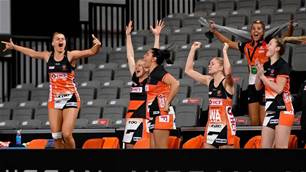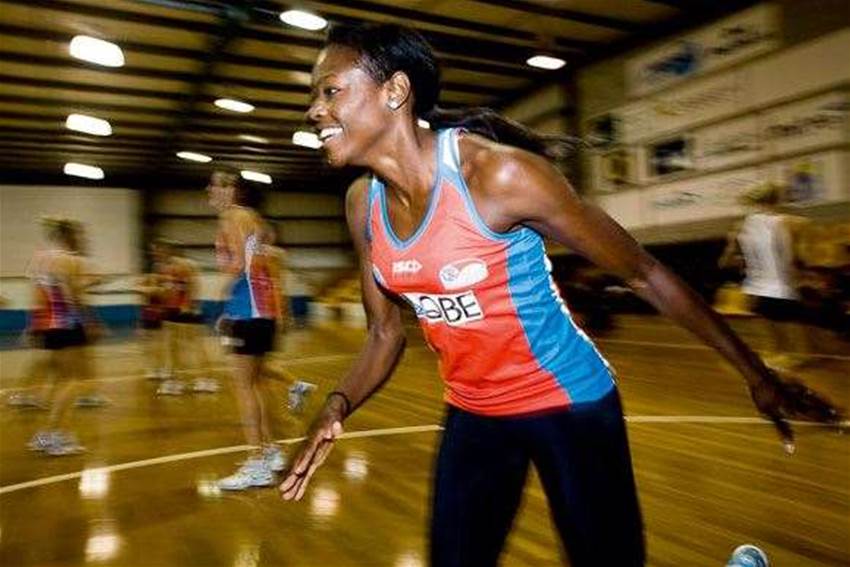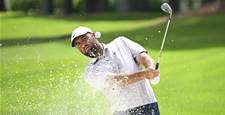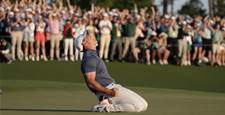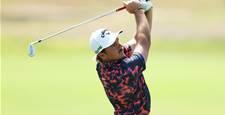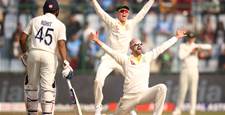To the uninitiated, piling on the points in netball can seem as easy as getting the ball down to a dead-eye Goal Attack or Goal Shooter and watching the scoreboard tick.
To the uninitiated, piling on the points in netball can seem as easy as getting the ball down to a dead-eye Goal Attack or Goal Shooter and watching the scoreboard tick. This is bloody harder than it looks, though, especially with defenders like Sonia Mkoloma lurking inside the circle.
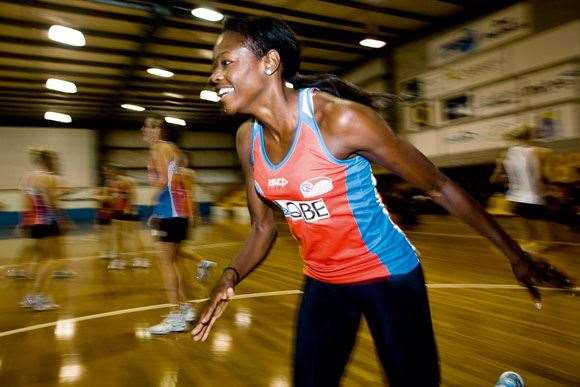 Sonia in training
Sonia in trainingImages: Getty Images
Mkoloma is the NSW Swifts’ import with 102 Test caps for England to her name. Australian and New Zealand netball wins on all counts having the former Central Pulse (2008) and Canterbury Tactix (’09) star plying her trade in the antipodes. Firstly, we get to see her silky skills up close in the trans-Tasman ANZ Championship week in, week out. Secondly, England officials have reversed their decision to judge their prospective overseas-based reps ineligible for the upcoming World Champs in Singapore in July ... Another win for fans of the international game as our nation eyes a three-Test home series against the Old Country in October.
If you have a netball-playing daughter (yes, yes, okay, or son) whose leaning towards spending her winter weekend mornings down the defensive end of the court, sit her in front of the TV for a Swifts game starring NSW’s 183cm London-born veteran.
Inside Sport caught Mkoloma one afternoon at a Swifts training session and asked her to take usto school on the finer points of netball defence.
PLAN OF ATTACK
“Each week the Swifts have two two-hour court sessions. These are made up of specific ball skills and unit work. Each courtwork session is broken up into smaller segments and then we join everything together. There’ll be full-team work, either as a full team in defence or a full team attacking the ball through the court. As I’m a defender, working on my combinations with my partners on the court is important.
“There’s two strength and conditioning sessions a week, too, which we actually do at the Sydney Swans’ gym. These sessions alter between strength components with weights, stamina, speed and conditioning.
“After that it depends on the individual. Some weeks you might feel like you could do with a little bit more work, so you might go to the gym and do a bike session. Or, say if you don’t play one weekend or you don’t get much court time, then you’ll do a top-up session, which may consist of interval swimming, a bike ride, a session on a cross trainer or a run. The top-up sessions last for a max of 50 minutes; because the competition’s so tight, you don’t want to overdo it and become fatigued.”
GOING TO COURT
“Our courtwork sessions tend to start with a warm-up, just getting our hand, eye and feet coordination fine-tuned; basic ball work, reaction drills. Then we break up into our units. The defensive unit is made up of the Goal Keeper, Goal Defence and Wing Defence. We’ll do specific stuff in and around the goal circle. It could be working towards the next match, or focussing on what hasn’t been working for us as a unit. We focus on man-on-man marking, setting up zones ...
“When we break into units, we’ll run through stuff like routine ballwork, stuff which will get us reacting. Then we might focus on centre pass defence. We’ll talk about what we want to get out of each tactic we practice, then we’ll run through it four or five times and talk about it again afterwards; about how we may be able to improve it. Then we’ll go out and hit it again. It’s good, specific work.
“What we focus on changes depending on what the team needs to get out of it and who the opposition is, especially in a tournament like the ANZ Championship, where the games are week in, week out. Some teams we only play once, so we know we need to analyse them, play them and move on. You can’t dwell on what happens against these teams because you’re not going to hit them again.”
GOOD “D”
“Defenders must be able to read the game well. We’re reactive players. It’s about predicting where the ball’s going to end up, what passes are going to be given, reacting to when the ball’s in the air. There’s a lot of reading the game. Some players are born with a defensive insight.
“I’m a defender in the circle, so my aim is to stop shooters from getting goals. Part of it is getting into a shooter’s head and trying to get them to second-guess themselves. If you’re doing that there’s only a 50-50 chance they’ll get the shot in. If you can make them second-guess whether you’re going to tip a shot or reject a shot, you’ve done a good job. In netball, when a team’s in defence, they just want the ball. At the back end you’ve got to be on the ball and backing yourself.”
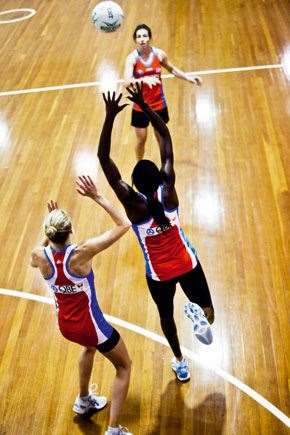 Sonia Mkloma NSW Swifts
Sonia Mkloma NSW SwiftsImages: Getty Images
SHARP SHOOTERS
“There are a lot deadly accurate shooters around. As an international player, I’ve played against Australia, the Kiwis, the Jamaican girls ... You play them in an international forum all the time and there’s some Goal Attacks and Shooters who just don’t miss. If you can get them down to say, a 90 per cent shooting average, you’ve done a good job. When these players are in the game, a lot of the pressure is on your front girls to get the ball before it gets down our end because you know they’re great shooters. There are times when you think, ‘I know I’m not going to stop everything.’ Sometimes it’s a tough and thankless job. Once you know you’re not going to save everything, you just try to stop what you can. Then your mindset is different; you don’t get down if you miss a few intercepts or blocked shots because they only come off sometimes, but you still need to work hard and give yourself the chance.”
FAVE PART
“I enjoy the unit and defence-specific training. When we look at video of our games I get to see where I’ve messed up; I like getting out on the court with smaller groups and working on where I personally need to improve. When I’m out on the court I need to understand what my partner’s doing. If I know she’s going left, I have to cover right, but that comes with practice and getting to know each other.”
… LEAST FAVE
“Netball isn’t one of those sports where you’re just running in straight lines. There’s a lot of jumping, explosive changes in direction as well ... In the Swifts’ weights sessions we do squats, jump squats, super sets; we might do a heavy load, then super-set it with a more active movement. We do bench presses, bench throws, jumping onto boxes for height, static jumps, lateral hops over hurdles, just to get our feet moving. It varies. It’s not just about pumping weights. There’s endurance and agility benefits from gym work as well as the obvious strength improvements. In saying all this, weight training is definitely my least favourite part of our training regime! After ten years of that, combined with the actual netball stuff, I’m over the weights. When we’re given our gym regime, I’m like, ‘Ugghh.’
“We tend to do three-five reps of each exercise, depending on what it is, for four sets. There are about ten exercises we do, but some are super-setted, so we do them back to back; it might be jump squats supersetted with squats to bench. The Swifts’ gym sessions usually last for about an hour and a half.”
TO THE VIDEO
“We tend to have video sessions first thing after the weekend. Our first courtwork session for the week will consist of 15-20 minutes’ of video work. We’ll look at the game we just played. We have special video analysts who break down the game. They’ll show us important statistics; how many centre passes were received, where we threw most balls away, where shooters shot the most from, how many intercepts, how many penalties ... Quite in-depth detail about each game. In that video session we’ll talk about ways of bringing the ball back out and bringing the game down the other end if we’re being cornered; basically looking at where we messed up in the game ‒ which is horrible. We’ll look at some of the stuff that worked well, too, and take it forward to the next game.”
THE NETTY SHOW
“I’d done a lot of netball-related media work in the UK over the years before coming out here. You do a lot of speeches relating to international matches, etc. I’m okay on it. Players at the Swifts can have individual media training, depending on what the needs are at that time. Some of the older players have done plenty of it. We just check with our media manager and she’ll give us a heads up on what’s expected of us.”
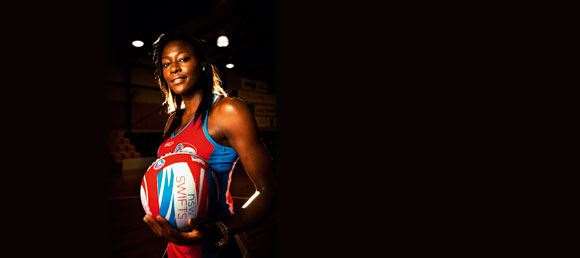 Sonia Mkloma Netball Portrait
Sonia Mkloma Netball PortraitImages: Getty Images
REFUELLING
“Immediately after training sessions it’s all about taking on fluids. Right now we’re into a drink called Sustagen – which rebuilds muscles – or any other protein milky drink. We aim to intake 150 per cent of our sweat loss, or at least two litres, trying to refuel back what fluids we’ve lost during a game. Everybody’s different. In the early phases of training we weigh ourselves before and after training to get an idea of how much we tend to lose during a session or in matchplay. In the change room there tends to be snacks ‒ fruits, sandwiches, bananas and lollies for quick sugar intake. Some people have ham, too, which is a good refueller. It’s all about getting these foods into us in the first hour or as soon as possible after a session.”
RECOVERY
“We have a stretch, which could last for 15 minutes, after training and games. Then we’re into an ice bath ‒ a lot of research has been done on ice recovery and cold-then-hot techniques. I think it’s been discovered that it’s different for each person and what each athlete needs. One person might stay in the ice bath for 20 minutes and feel great, another might do hot and cold – 30 seconds in ice and 30 seconds in a hot bath. It’s about muscle rebuilding and reducing further injury risk. Personally, it depends on how achy I feel as to how long I’ll spend in the ice bath. Sometimes I get in and the water’s just too cold, so I’ll just do 30 seconds in and 30 seconds out and still feel like I’m getting benefits out of it.”
WORLD OF NETBALL
“There’s very little difference between the training regimes and methods between here and back home in the UK. I’ve been lucky because my conditioner from England has come out here a couple of times and met with my Australian weight trainers. They’re good at sharing information. The basic principles are the same – you might be doing different exercises, but all aspects tend to point in the same directions.”
NEW TRICKS
“In the UK I tended to play Goal Defence for England. I’d have a different perspective on the game to what I have now. I’d be doing a lot more backward running. I’d be going back, going forward for intercepts, or backing up and jumping at different angles and stuff. Since being out here for the last two years in Sydney, I’ve been playing more Goal Keeper, which isn’t something I’d done for six years. It covers less ground but you’re expected to do more confined work on your Goal Shooters.
“Each session I’m always picking the coach’s and assistant coach’s brains on what I can do better. I’m always learning new things about what’s required from my body and what it’s actually capable of. Each week through this tournament I’ve been learning
that little bit more.”
‒ James Smith
Related Articles
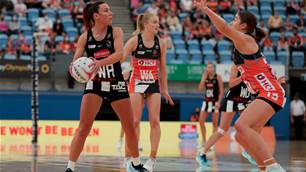
Round 2 Suncorp Super Netball Pic Special

'A dream come true': NSW Swifts 2020 Preview
